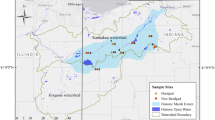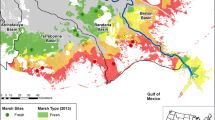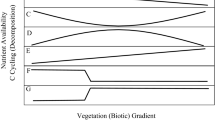Abstract
Tidal salt marshes provide important ecological services, habitat, disturbance regulation, water quality improvement, and biodiversity, as well as accumulation and sequestration of carbon dioxide (CO2) in vegetation and soil organic matter. Different management practices may alter their capacity to provide these ecosystem services. We examined soil properties (bulk density, percent organic C, percent N), C and N pools, C sequestration and N accumulation at four marshes managed with open marsh water management (OMWM) and four marshes that were not at U.S. Fish and Wildlife National Wildlife Refuges (NWRs) on the East Coast of the United States. Soil properties (bulk density, percent organic C, percent N) exhibited no consistent differences among managed and non-OMWM marshes. Soil organic carbon pools (0–60-cm depth) also did not differ. Managed marshes contained 15.9 kg C/m2 compared to 16.2 kg C/m2 in non-OMWM marshes. Proportionately, more C (per unit volume) was stored in surface than in subsurface soils. The rate of C sequestration, based on 137Cs and 210Pb dating of soil cores, ranged from 41 to 152 g/m2/year. Because of the low emissions of CH4 from salt marshes relative to freshwater wetlands and the ability to sequester C in soil, protection and restoration of salt marshes can be a vital tool for delivering key ecosystem services, while at the same time, reducing the C footprint associated with managing these wetlands.



Similar content being viewed by others
References
Anisfeld SC, Tobin MJ, Benoit G (1999) Sedimentation rates in flow-restricted and restored salt marshes in the Long Island Sound. Estuaries 22(2A):231–244
Armentano TV, Woodwell GM (1975) Sedimentation rates in a Long Island marsh determined by 210Pb dating. Limnol Oceanogr 20(3):452–456
Artigas F, Shin JY, Hobble C, Marti-Donati A, Schäfer KVR, Pechmann I (2015) Long term carbon storage potential and CO2 sink strength of a restored salt marsh in New Jersey. Agric For Meteorol 200:313–321
Barbier EB, Hacker SD, Kennedy C, Koch EW, Stier AC, Silliman BR (2011) The value of estuarine and coastal ecosystem services. Ecol Monogr 81(2):169–193
Bartlett KB, Harriss RC (1993) Review and assessment of methane emissions from wetlands. Chemosphere 26(1–4):261–330
Blake GR, Hartage KH (1986) Bulk density. In: Klute A (ed) Methods of soil analysis. Part 1. Physical and mineralogical methods. Agron Monogr 9. ASA and SSSA, Madison, pp 363–375
Bourn WS, and Cottam C (1950) Some biological effects of ditching tidewater marshes. Research Report 19. Fish and Wildlife Service, U.S. Department of Interior, Washington, USA
Bricker-Urso S, Nixon SW, Cochran JK, Hirschberg DJ, Hunt C (1989) Accretion rates and sediment accumulation in Rhode Island salt marshes. Estuaries 12(4):300–317
Bridgham SD, Megonigal JP, Keller JK, Bliss NB, Trettin C (2006) The carbon balance of north American wetlands. Wetlands 26(4):889–916
Chmura GL, Anisfeld SC, Cahoon DR, Lynch JC (2003) Global carbon sequestration in tidal, saline wetland soils. Global Biogeochem Cycles 17(4):2201–2212
Church TM, Lord CJ III, Somayajulu BLK (1981) Uranium, thorium, and lead nuclides in a Delaware salt marsh sediment. Estuar Coast Shelf Sci 13:267–275
Clark JS, Patterson WA III (1984) Pollen, Pb-210, and opaque spherules: an integrated approach to dating and sedimentation in the intertidal environment. J Sediment Petrol 54(4):1251–1265
Craft C (2007) Freshwater input structures soil properties, vertical accretion, and nutrient accumulation of Georgia and U.S. tidal marshes. Limnol Oceanogr 52(3):1220–1230
Craft C, Megonigal P, Broome S, Stevenson J, Freese R, Cornell J, Zheng L, Sacco J (2003) The pace of ecosystem development of constructed Spartina alterniflora marshes. Ecol Appl 13(5):1417–1432
Crain CM, Gedan KB, Dionne M (2009) Tidal restrictions and mosquito ditching in New England marshes. In: Silliman BR, Grosholz ED, Bertness MD (eds) Human impacts on salt marshes a global perspective. University of California Press, Berkeley, pp 149–169
DeLaune RD, White JR (2012) Will coastal wetlands continue to sequester carbon in response to an increase in global sea level?: a case study of the rapidly subsiding Mississippi river deltaic plain. Clim Change 110:297–314
Diaber FC (1986) Conservation of tidal marshes. Van Nostrand Reinhold Co., New York
Duarte CM, Middelburg JJ, Caraco N (2005) Major role of marine vegetation on the oceanic carbon cycle. Biogeosciences 2:1–8
Emmett-Mattox S, Crooks S, Findsen J (2010) Wetland grasses and gases: are tidal wetlands ready for the carbon markets? Natl Wetlands Newslett 32(6):6–10
Environmental Protection Agency (2014) Calculations and references. Clean energy. http://www.epa.gov/cleanenergy/energy-resources/refs.html. Accessed 12 Sep 2014
Ferrigno F, Jobbins DM (1968) Open marsh water management. In: Proceedings of the Annual Meeting of the New Jersey Mosquito Extermination Association 55:104–115
Ingraham MW, Foster SG (2008) The value of ecosystem services provided by the U.S. National Wildlife Refuge System in the contiguous U.S. Ecol Econ 67:608–618
James-Pirri MJ, Erwin RM, Prosser DJ (2008) US Fish and Wildlife Service (Region 5) Salt Marsh Study, 2001–2006: an assessment of hydrologic alterations on salt marsh ecosystems along the Atlantic coast. USGS Patuxent Wildlife Research Center and University of Rhode Island, Final Report to U.S. Fish and Wildlife Service, April 2008. p 427
Kim G, Alleman LY, Church TM (2004) Accumulation records of radionuclides and trace metals in two contrasting Delaware salt marshes. Mar Chem 87:87–96
Kirwan ML, Blum LK (2011) Enhanced decomposition offsets enhanced productivity and soil carbon accumulation in coastal wetlands responding to climate change. Biogeosciences 8:987–993
Mcleod E, Chmura GL, Bouillon S, Salm R, Björk M, Duarte CM, Lovelock CE, Schlesinger WH, Silliman BR (2011) A blueprint for blue carbon: toward an improved understanding of the role of vegetated coastal habitats in sequestering CO2. Front Ecol Environ 9(10):552–560
Morris JT, Sundareshwar PV, Nietch CT, Kjerfve B, Cahoon DR (2002) Responses of coastal wetlands to rising sea level. Ecology 83(10):2869–2877
National Oceanic and Atmospheric Administration (2013) Sea level trends. Tides and currents. http://tidesandcurrents.noaa.gov/sltrends/. Accessed 7 Apr 2014
Natural Resources Conservation Service (2012) Web soil survey www.websoilsurvey.nrcs.usda.gov/. Accessed 15 June 2012, verified 22 Feb 2013). NRCS, Washington
Olander LP, Cooley DM, Galik CS (2012) The potential role for management of U.S. public lands in greenhouse gas mitigation and climate policy. Environ Manag 49:523–533
Orson RA, Warren RS, Niering WA (1998) Interpreting sea level rise and rates of vertical marsh accretion in a southern New England tidal salt marsh. Estuar Coast Shelf Sci 47:419–429
Pendleton L, Donato DC, Murray BC, Crooks S, Jenkins WA, Sifleet S, Craft C, Fourqurean JW, Kauffman JB, Marbà N, Megonigal P, Pidgeon E, Herr D, Gordon D, Baldera A (2012) Estimating global “blue carbon” emissions from conversion and degradation of vegetated coastal ecosystems. PLoS One 7(9):1–7
Pendleton LH, Sutton-Grier AE, Gordon DR, Murray BC, Victor BE, Griffis RB, Lechuga JAV, Giri C (2013) Considering “coastal carbon” in existing U.S. Federal statutes and policies. Coast Manag 41(5):439–456
Phillips JD (1986) Coastal submergence and marsh fringe erosion. J Coastal Res 2(4):427–436
Poffenbarger HJ, Needelman BA, Megonigal JP (2011) Salinity influence on methane emissions from tidal marshes. Wetlands 31:831–842
Portnoy JW, Giblin AE (1997) Biogeochemical effects of seawater restoration to diked salt marshes. Ecol Appl 7(3):1054–1063
Roman CT, Peck JA, Allen JR, King JW, Appleby PG (1997) Accretion of a New England (U.S.A.) salt marsh in response to inlet migration, storms, and sea-level rise. Estuar Coast Shelf Sci 45:717–727
SAS Institute Inc. (2011) SAS/ACCESS® 9.3 Interface to Files: Reference. SAS Institute Inc, Cary
Sebold KR (1992) From marsh to farm: the landscape transformation of coastal New Jersey. U.S. Department of the Interior, National Parks Service. Historic American Buildings Survey/Historic American Engineering Record, Washington. http://www.nps.gov/history/history/online_books/nj3/index.htm. Accessed 18 April 2014
Silliman BR, Bertness MD (2004) Shoreline development drives invasion of Phragmites australis and the loss of plant diversity on New England salt marshes. Conserv Biol 18(5):1424–1434
Soil Conservation Service (1975) Soil survey of Suffolk County. New York. U.S. Gov. Print. Office, Washington
Soil Conservation Service (1978) Soil survey of Atlantic County. New Jersey. U.S. Gov. Print. Office, Washington
Soil Conservation Service (1982) Soil survey of York County. Maine. U.S. Gov. Print. Office, Washington
Soil Conservation Service (1984) Soil survey of Essex County, Massachusetts. Southern Part. U.S. Gov. Print. Office, Washington
Sutton-Grier AE, Moore AK, Wiley PC, Edwards PET (2014) Incorporating ecosystem services into the implementation of existing U.S. natural resource management regulations: operationalizing carbon sequestration and storage. Mar Policy 43:246–253
UNEP and CIFOR (2014) Guiding principles for delivering coastal wetland carbon projects. United Nations Environment Programme, Nairobi, Kenya and Center for International Forestry Research, Bogor, Indonesia, pp 57
Vincent RE, Burdick DM, Dionne M (2013) Ditching and ditch-plugging in New England salt marshes: effects on hydrology, elevation, and soil characteristics. Estuar Coast 36:610–625
Wolfe RJ (1996) Effects of open marsh water management on selected tidal marsh resources: a review. J Am Mosq Control Assoc 12:701–712
Wolfe RJ (2005) Open marsh water management: a review of system designs and installation guidelines for mosquito control and integration in wetland habitat management. In: Proceedings of the New Jersey Mosquito Control Association vol 92, pp 3–14
Acknowledgments
We would like to thank Annie Bowling and Ellen Herbert for their help with field sampling and laboratory analyses. We would also like to thank our friends at the Refuges studied for their assistance in preparation and in the field: Sarah Janson, Nancy Pau, Curt Kessler, Monica Williams, Paul Castelli, and William Crouch. We also thank our two anonymous reviewers for their thoughtful and comprehensive comments. Funding for this study was provided by the U.S. Fish and Wildlife Service Land Management Research and Demonstration Areas. The findings and conclusions in this article are those of the authors and do not necessarily represent the views of the U.S. Fish and Wildlife Service.
Conflict of interest
The authors declare that they have no conflicts of interest.
Author information
Authors and Affiliations
Corresponding author
Rights and permissions
About this article
Cite this article
Drake, K., Halifax, H., Adamowicz, S.C. et al. Carbon Sequestration in Tidal Salt Marshes of the Northeast United States. Environmental Management 56, 998–1008 (2015). https://doi.org/10.1007/s00267-015-0568-z
Received:
Accepted:
Published:
Issue Date:
DOI: https://doi.org/10.1007/s00267-015-0568-z




